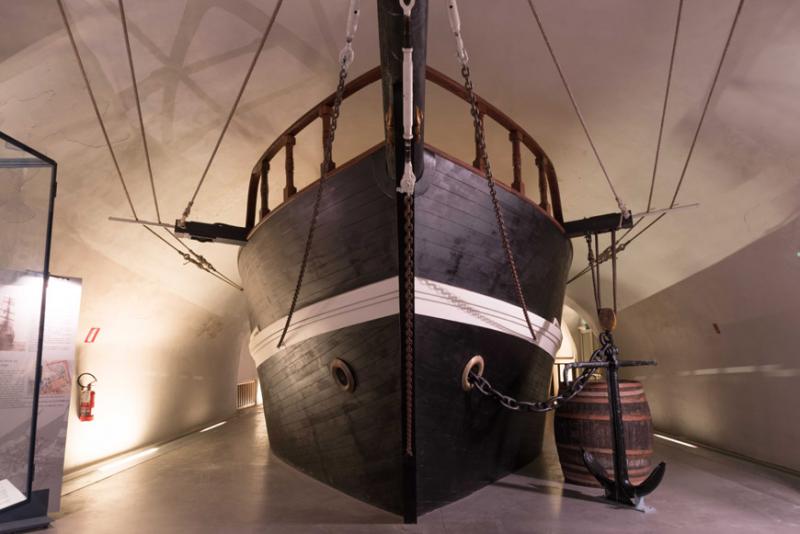Visit the Galata Museum in Genoa, the largest maritime museum in the Mediterranean
ITA:

Use player to listen to Italian version
The Galata Museum in Genoa is the largest maritime museum in the Mediterranean. Located in what was once the arsenal of the powerful Republic of Genoa, where galleys were built, armed and launched, the museum, inaugurated in 2004, allows the visitor to make a journey through five centuries of maritime history and life, with the chance to visit a reconstructed galley from the 17th century, to go onboard a steamer, or embark on a ship bound for the Americas like early 20th century migrants did.
Maritime history is narrated through the four ages of navy history: oars and galleys, sail and vessels, steam and steamships, cruise ships and migrations.
The ground floor displays the history of the port of Genoa, with its protagonists and symbols, such as the reconstructed galley, and a portrait of Christopher Columbus.
The first floor is devoted to maritime life between the 16th and 17th centuries, when Genoa was a powerful independent state. Here you can not only admire the atlases used by sailors in the past, but also browse through them, thanks to multimedia equipment.
The third floor hosts the part dedicated to the transition from galley to ship, and from the ‘art’ to the ‘science’ of navigation. Through virtual reality, visitors can even experience a shipwreck, complete with raft movements, splashes of water, thunder and lightning.
The third floor is dedicated to migrations and to the stories of the many Italians who, between the end of the 19th century and the beginning of the 20th century, left Italy. There is also a section devoted to more recent migration flows, those that began toward the mid-20th century from Africa and Asia toward Europe.
On the Mirador terrace on the top floor it is possible to admire a view of Genoa and its port from high above.
To complete the visit, it is worth to visit the docks and the Nazario Sauro submarine, moored outside the museum.
Il Galata – Museo del Mare di Genova è il più grande museo marittimo del Mediterraneo. Situato in quello che un tempo era l'arsenale della potente Repubblica di Genova, dove le galee venivano costruite, armate e lanciate, il museo, inaugurato nel 2004, consente al visitatore di fare un viaggio attraverso cinque secoli di storia e vita marittima, con la possibilità di visitare una galea ricostruita del 17° secolo, salire a bordo di un piroscafo o imbarcarsi su una nave diretta verso le Americhe come facevano i migranti di inizio Novecento.
La storia del mare è narrata attraverso le quattro epoche della storia della navigazione: quella dei remi e delle galee, quella della vela e delle navi; quella delle navi a vapore, e quella delle navi da crociera e delle migrazioni.
Il piano terra illustra la storia del porto di Genova, con i suoi protagonisti e simboli, come la galea ricostruita, e un ritratto di Cristoforo Colombo.
Il primo piano è dedicato alla storia marittima tra il XVI° e XVII° secolo, quando Genova era un potente stato indipendente. Qui non solo si possono ammirare gli atlanti usati dai marinai in passato, si può anche sfogliarli, grazie alle attrezzature multimediali.
Il terzo piano ospita la parte dedicata al passaggio dalla galea al vascello e dall'’arte’ alla ‘scienza’ della navigazione. Attraverso la realtà virtuale, i visitatori possono persino sperimentare un naufragio, completo di movimenti di zattera, spruzzi d'acqua, tuoni e fulmini.
Il terzo piano è dedicato alle migrazioni e alle storie di molti italiani che, tra la fine del XIX° secolo e l'inizio del XX° secolo, hanno lasciato l'Italia. C'è anche una sezione dedicata ai flussi migratori più recenti, quelli che sono iniziati verso la metà del 20° secolo dall'Africa e dall'Asia verso l'Europa.
Sulla terrazza del Mirador all'ultimo piano è possibile ammirare dall'alto Genova e il suo porto.
Per concludere la visita, vale la pena visitare le banchine e il sottomarino Nazario Sauro, ormeggiato fuori dal museo.











